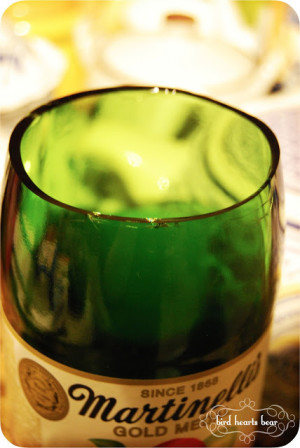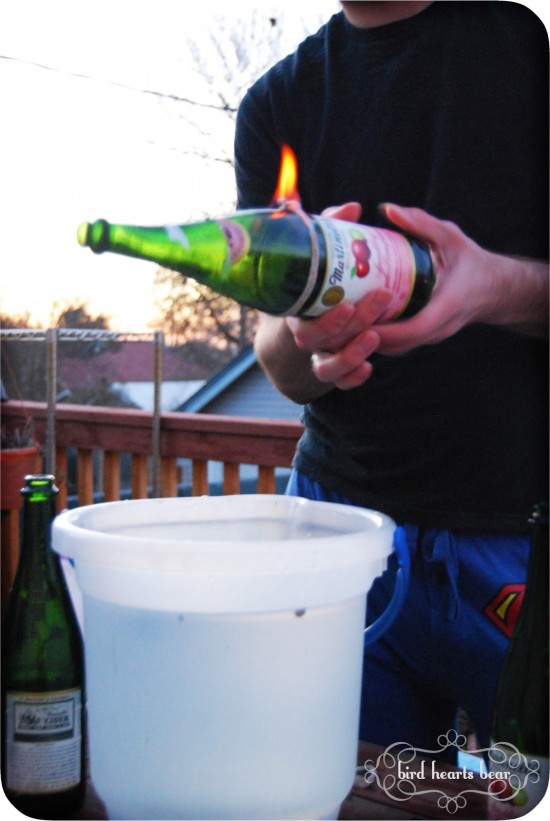Remember when Homie ChaeBird took a chicken to the vet? Now she’s back to tell us about turning wine bottles into vases using fire, instead of using dangerous power tools.
 There have been lots of tutorials on Pinterest about how to turn wine bottles into vases or tumblers.
There have been lots of tutorials on Pinterest about how to turn wine bottles into vases or tumblers.
Some of our dear friends are getting married, and wanted to try it out as possible DIY reception decor. So I volunteered our space to experiment with glass bottles and fire.
Turns out this wine bottle trick works pretty well!
What you need:
- Bottles
- Kitchen twine
- Acetone (nail polish remover)
- Bucket of ice water
- Lighter
What we did:
 I turned a storage barrel into a magical wine table!
I turned a storage barrel into a magical wine table!
I'm becoming a bit of a recycling center junkie -- my husband and I go for a "hot date" every week and come home with... Read more
Cut a length of kitchen twine long enough to wrap around the bottle four or five times. Then soak it in acetone(nail polish remover). Wrap the twine around the bottle, tie it in place, and light. Make sure your fingers are a safe distance away from the flaming twine.

Rotate the bottle quickly and evenly, so the flames run around the length of twine. This may take a few minutes, and you should be able to turn the bottle a good half-dozen times before the flames die down. Once the flames go out, immediately immerse the bottle in the bucket of ice water, with the neck pointing down.

The bottle should separate into two pieces with a loud “crack!”

Our first couple of attempts yielded somewhat uneven and rough edges, but after a bit of practice, the bottles started separating cleanly.



Obviously the edges will need to be sanded and smoothed, but overall we were all very impressed by how well this method worked.


OMG. I have this fabulous wine bottle with a raised gold painted monkey on it and I have been waiting for a tutorial to make it into an amazing vase forever! THIS IS PERFECT.
Yay! I’m glad you like the tutorial. I hope you post pictures of your vase to the Offbeat Home flickr pool, I’d love to see it. 😀
YES! Submit the after to our Flickr pool por favor!
don’t forget to have a few practice runs first on regular bottles to get your technique down pat before you try on the nice bottles.
What an awesome idea!! I’m so going to try this!
This is a great idea but the acetone fumes freak me out. Is it necessary? Has anyone used anything in its place?
Doing it outside, I really couldn’t smell anything, even with my super-sensitive pregnant nose. I didn’t participate in the actual activity though, to be safe. I think you could use some other flammable substance, but you’d definitely want to be careful.
I *promise* acetone is not the scariest thing in the world. I work in manufacturing and in my old area, I used it roughly every day. Sometimes in large quantities… and without a respirator. If you do this outside and don’t cover yourself with the stuff, you’ll be just fine.
Acetone fumes freak me out too, so I tried this months ago with both rubbing alcohol and lighter fluid. Neither worked for shit. So I’ll be trying it again with acetone instead and just making sure I’m outside in good ventilation.
hmmm… I have some buddah-shaped beer bottles lying around somewhere…
I saw a tutorial on pintrest where you heat the glass with the flame from a candle and then run an ice-cube around it, but I didn’t fancy having my fingers that close to the glass when it breaks, this seems much saver, if maybe a little less accurate (but then it may be just as accurate, not having tried either myself…)
I built a DIY bottle cutting jig a bit like this tute:
http://www.instructables.com/id/Want-to-cut-wine-bottles-Build-this-jig/?ALLSTEPS
Having tried both, I found it gives you a much cleaner, more controllable cut that requires much less grinding down and cleaning up than the scary firey chimical soaked string method. There is also much less chance of the bottle exploding from the change in temperature. Glass can have tiny, un-noticable flaws, un-noticable until you subject it to extremes of temperature. Please, please remember your safety glasses and gloves and wear long sleeves. Experimentation is fun, hospital is not!
so much this. I have a fancy $50 bottle cutter called a kinkajou that works awesome. Spendy but any other method and I felt like I was gonna have glass in my eye. totally worth it to feel safe
I work with glass for a living and I have to say that you should be wearing a resperator if you are going to be sanding glass, you don’t want to be breathing glass particles. If you are wanting to use an electric grnder of some kind like a Dremel make sure you don’t over heat the glass or it can crack, and still wear a resperator. Also you can get diamond imbedded sand paper that will be the best way to smooth those edges.
If you are going to be making a lot of these it may be worth buying a bottle cutter.
I use grinders and glass saws in my work with glass but all my tools are designed to work with water so that I am not breathing glass dust. Saftey first everybody.
I found this method to work best. A perfect cut nearly ever time. The right tool works wonders!
I bought one of those cutters to make bottle vases for my wedding reception, and it took my sister and me hours (plus a dozen bottles) to get just a few clean cuts. The bottles looked so amateur that we ended up recycling them all and yarn-wrapping intact ones instead. In conclusion, if anyone wants my gently used bottle cutter, I’ll mail it to you. 😉
I bought a $20 Generation Green bottle cutter from Amazon and had the same experience as you. I bought a $50 kinkajou from their website and it works PERFECTLY once you get the hang of it – and I got the hang of it within a couple of cuts.
I just purchased a Kinkajou glass cutter to make beer bottle centrepieces for our wedding! I found the twine and fire method really unpredictable, so I have high hopes for the Kinkajou!
i just got married and used wine bottles for flower vases and made shorter ones for candles. I have a ceramic and glass studio and had plenty of bottles to experiment with. I found the most consistent cuts come from a tool called G2 bottle cutter. Its about $20 and cut through 200+ bottles without a problem. all you need is that tool, a large pot of hot water and running cold water (ice cold bucket doesn’t work). Just a suggestion that can save you frustration and money in the long haul1
Fantastic tutorial and I have some collection of old wine bottles. I will try to make this kind of crafts. I think bottle cutting is the main work, so I will try a cutter.